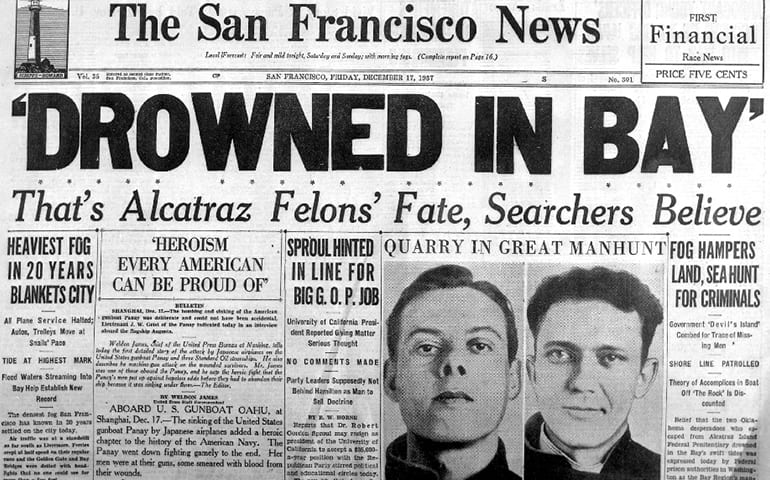Featured in this post
Keep Exploring
San Francisco, California
Alcatraz City Cruises
Explore More
Guest Blog Post – Michael Esslinger
TTwo escapes, occurring on the same day a quarter century apart and both aided by dense fog, helped shape the lore of Alcatraz, the last stop for America’s most infamous criminals. It was the one prison touted as being inescapable and was reserved for an elite one percent of America’s most ruthless criminals. They were to be housed in a prison that would confine less than 300 men at any given time and serve as the ultimate punishment for those who pushed back against the system. This was the mindset of government officials in the 1930s and they believed it was a promising solution.
Escape(s) From Alcatraz
December 16th is an important anniversary for Alcatraz Island. Two historically significant escape attempts occurred 25 years apart on the same date. One continues to remain unsolved, deeply shrouded in speculation and the other drove the final stake and shattered the once rock-solid reputation that Alcatraz was escape proof. They are often glanced over in history books, but both serve as important bookends to the island’s history of infamous escapes.
On October 26, 1935, two convicts stepped off the McDowell, the official ferryboat operated by correctional officers of Alcatraz Island. Theodore “Ted” Cole and Ralph Roe both made the trek together from the federal prison in Leavenworth, Kansas to their new infamous home Alcatraz Island sitting in the middle of the San Francisco Bay. The two men had first met at “Big Mac,” the state penitentiary located in McAlester, Oklahoma and then later crossed paths again while at Leavenworth. Cole had a violent criminal history of armed robberies that began at age fourteen. By his early twenties, his fury of crime led to a death sentence after District Judge Saul Yager speculated that his criminal acts would eventually turn to murder. In a highly publicized trial, he was given the nickname “Teddy the Terror” and sentenced him to die in the Oklahoma electric chair. On the day of his sentencing, there were loud gasps in the courtroom as the judge held firm and explained “The boy is a potential killer and deserves such a sentence… He will not stop these types of crimes… It’s in his blood.” The public at large didn’t agree that Cole deserved death and facing the death penalty without having committed murder became the focus of nationwide protests led by various women’s groups and civil-rights organizations. Cole appealed and won… His sentence was reduced to fifteen years in a state penitentiary.
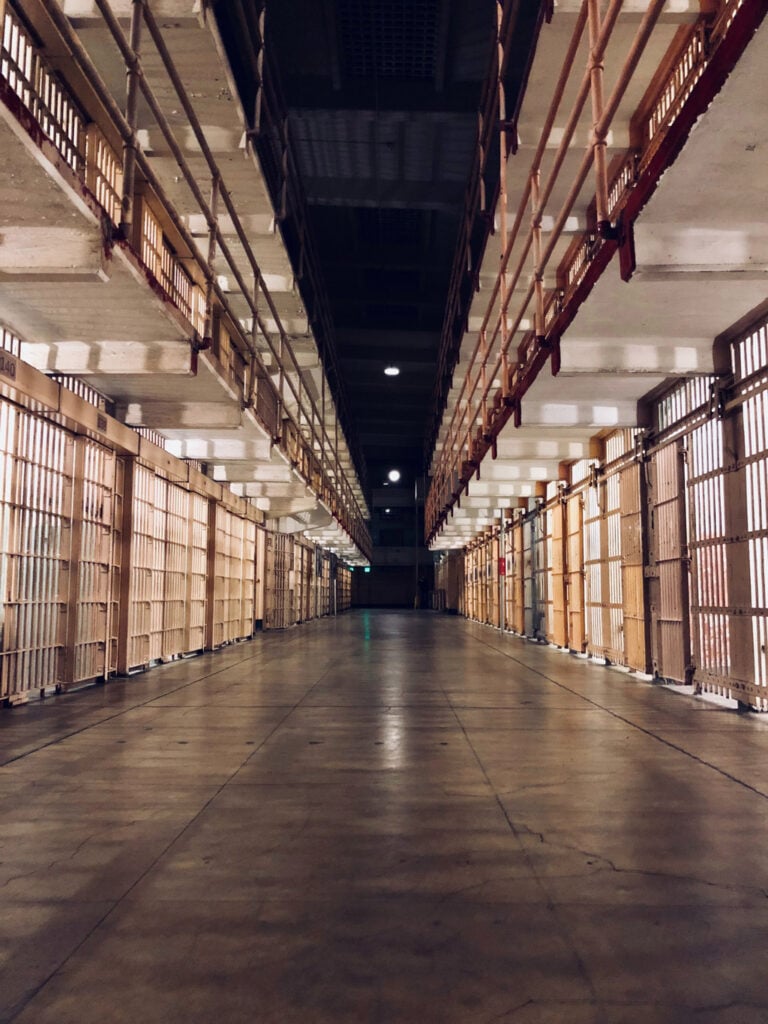 Cole didn’t adjust to prison life and bringing truth to Yager’s original claim, Cole brutally murdered his cellmate. He claimed it was self-defense and after a lengthy trial, the jury deadlocked. The charges were eventually dropped and the case was never retried in court. The clever Cole never stopped scheming and finally, in November of 1934, the thin-framed Teddy secreted himself into a laundry bag, loaded into a truck and then made his way to freedom. After making it to town he took a hostage, crossed state lines into Texas and committed a string of robberies before again being captured. He was sentenced to 50 years for kidnapping and was ultimately recommended for Alcatraz.
Cole didn’t adjust to prison life and bringing truth to Yager’s original claim, Cole brutally murdered his cellmate. He claimed it was self-defense and after a lengthy trial, the jury deadlocked. The charges were eventually dropped and the case was never retried in court. The clever Cole never stopped scheming and finally, in November of 1934, the thin-framed Teddy secreted himself into a laundry bag, loaded into a truck and then made his way to freedom. After making it to town he took a hostage, crossed state lines into Texas and committed a string of robberies before again being captured. He was sentenced to 50 years for kidnapping and was ultimately recommended for Alcatraz.
Ralph Roe had also been a well-known criminal with crimes dating back into his teen years. He was also an associate of the famed outlaw Wilbur Underhill, known during that era as the “Tri-State Terror.” Both Roe and Underhill would be taken down together. In December of 1933 as wanted fugitives, federal agents traced their whereabouts to a small cottage in Shawnee, Oklahoma, where they were hiding out. Using the cover of darkness, federal agents surrounded the property and demanded them to surrender. Within seconds, a gun battle erupted and under a volley of bullets, Roe and his girlfriend, Eva May Nichols, were both struck down. Underhill suffered numerous gunshot wounds but managed to escape. He was found hiding in a furniture store hours later, critically injured having suffered extreme blood loss from numerous gunshot wounds. Underhill was taken to McAlester where he remained, handcuffed in his bed, at the prison hospital until his death several days later. Ralph’s girlfriend Eva Nichols would also later die from her bullet wounds, but Roe survived and was sent to prison to serve out a life sentence.
For both Cole and Role, the ride on the narrow sea vessel, the McDowell, was turbulent as it navigated the bay waters of San Francisco. This was a special ferry ride and U.S. Marshals rode in a Coast Guard chase boat with rifles at the ready. This was unusual and not standard but the passengers riding the ferry on October 25, 1935 were some of America’s most aggressive criminals and escape risks. On the same chain was Doc Barker and Thomas Limerick, who would both later die in their own escape attempts and Rufus McCain who was later murdered by Henry Young on Alcatraz. McCain’s murder had been rumored to stem from a failed escape with Barker and Young held a grudge claiming that he had announced on the shore he didn’t know how to swim. Homer Binkley, the crime partner of Burton Phillips, was also on the same ferry. At only 26 years of age, Binkley was a notorious bank robber of the Midwest and known for violent prison breaks. And finally, John F. Goode, a notorious bank robbery who opened fire on police officers in a desperate attempt to evade capture. The Rock was to be their final stop.
When the men arrived on Alcatraz, it was during the strict era where the Rule of Silence was in full force. Men were only allowed to talk quietly during meal and recreation periods and talking in the Cellhouse could land you in the dungeon. It was considered hard time and men dreamed day and night of escaping back to freedom. Roe was considered a menace on Alcatraz, often seeing time in isolation for inciting discord amongst the inmate population. After serving three months in solitary confinement, in March of 1936, Ralph was released back to the general population and assigned to work in the mat shop. Cole would follow months later, first being assigned a job in the laundry, then a position in the blacksmith shop. Together, they would plot the first debatable ‘successful’ break from “the Rock”.
The Day Roe and Cole Escaped from Alcatraz
On the day of the escape, Roe was working alongside 25 inmates who included Bernard Coy (the principal of the 1946 Battle of Alcatraz), Doc Barker and Rufus McCain. Cole was assigned to the blacksmith shop along with five others, including John Paul Chase and Jack Lloyd, one of Roe’s crime partners in several Oklahoma bank heists. Using hacksaw blades, the men had sawed through the metal detention sash of the window, and both puttied and painted over the sections to prevent any detection. Officers made rounds every 30 minutes, so they had to be crafty in concealing their work.
On the morning of December 16, 1937, shortly before 11:00 AM, Ted Cole made his way up the stairs in the Model Industries Building and entered the furniture factory, located directly above the mat and blacksmith shops. The FBI later believed it was Francis Harper, 283-AZ, who had served as the key figure by helping provide Cole access into the other shops. The FBI contended that Harper provided critical details of the building layout as he was one of the few inmates who was able to roam the various sections of the building. He has also had been seen talking with Cole numerous times before the escape.
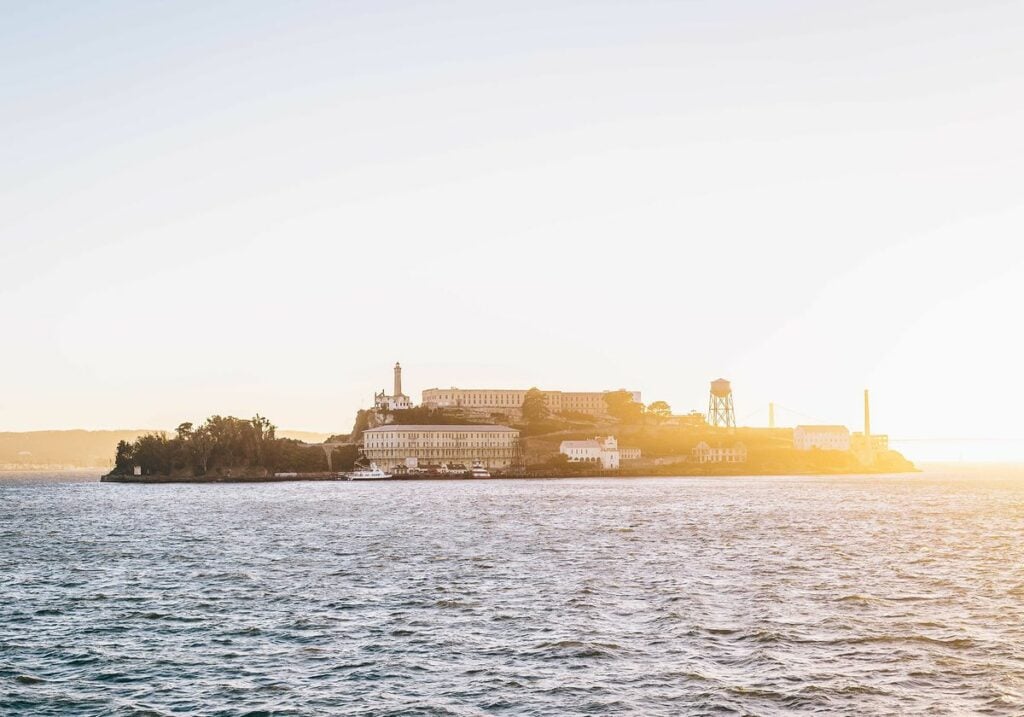 The fog was so dense that morning and was described as being as thick as “pea soup” with the visibility varying from a few hundred feet, then down to zero as mass layers rolled past the island. The powerful water currents running through the Golden Gate ranged from between seven and nine knots, creating what were considered death-trap conditions for anyone willing to try their fate in the perilous waters. It’s unlikely that the two inmates were aware of exactly how dangerous the currents and foggy conditions were, but it was speculated that they might have seen the heavy fog as ideal for cover.
The fog was so dense that morning and was described as being as thick as “pea soup” with the visibility varying from a few hundred feet, then down to zero as mass layers rolled past the island. The powerful water currents running through the Golden Gate ranged from between seven and nine knots, creating what were considered death-trap conditions for anyone willing to try their fate in the perilous waters. It’s unlikely that the two inmates were aware of exactly how dangerous the currents and foggy conditions were, but it was speculated that they might have seen the heavy fog as ideal for cover.
During his normal rounds, the officer assigned to the model building returned to the mat-shop for the 1:30 PM count and discovered Cole and Roe both missing from their work stations. As he hurriedly searched the shop, he noticed punched-out panes of glass and the bent-out steel grill that clearly had been cut with a large enough opening for the men to pass through. It is speculated that after sawing the bars, Roe and Cole bent them out using a heavy wrench, punched out two panes of glass and climbed through the window, dropping to the ground below and running to the locked gate and path that led down to the shoreline. It is also believed that in preparation for the escape, the two inmates had constructed floats from lightweight metal five-gallon fuel canisters with specially made handles and carried these makeshift floats with them. The two men had disappeared and were never seen or heard from again… Theodore Audett, the only convict to serve three separate terms on Alcatraz, later claimed that he watched the two inmates as they entered the bay and began their swim. He said that he saw Roe come up out of the water several yards off the island…he appeared to be struggling to stay afloat in the turbulent currents and then disappeared into the dense fog. Cole swam into the fog and then disappeared.
The FBI conducted extensive interviews with every officer and created lengthy written profiles to rule out any inside assistance or weak points in security. They interviewed every prisoner in the building and worked everyone possible lead. Nothing… Despite one of the most complex and exhaustive manhunts that spanned the United States and South America, the FBI came up with zero leads. The FBI investigative reports include more than 500 pages of dead-end leads. They never found any definitive trace of the two men.
Four years following the escape, a reporter for the San Francisco Chronicle ran a story suggesting Cole and Roe had made it to South America and had both survived. He wrote that they had resided in Peru and Chile and made claim that they were the only prisoners ever to stage a successful break from “the Rock.” He claimed they were thriving and both living as free men. Warden James A. Johnston and the San Francisco Bureau of the FBI firmly disputed the claims stating they were unfounded, unconfirmed and “foolish stories” contrived by reporters. It remains one of the grand mysteries of Alcatraz and the case was never solved.
Now fast forward 25 years to December 16, 1962…
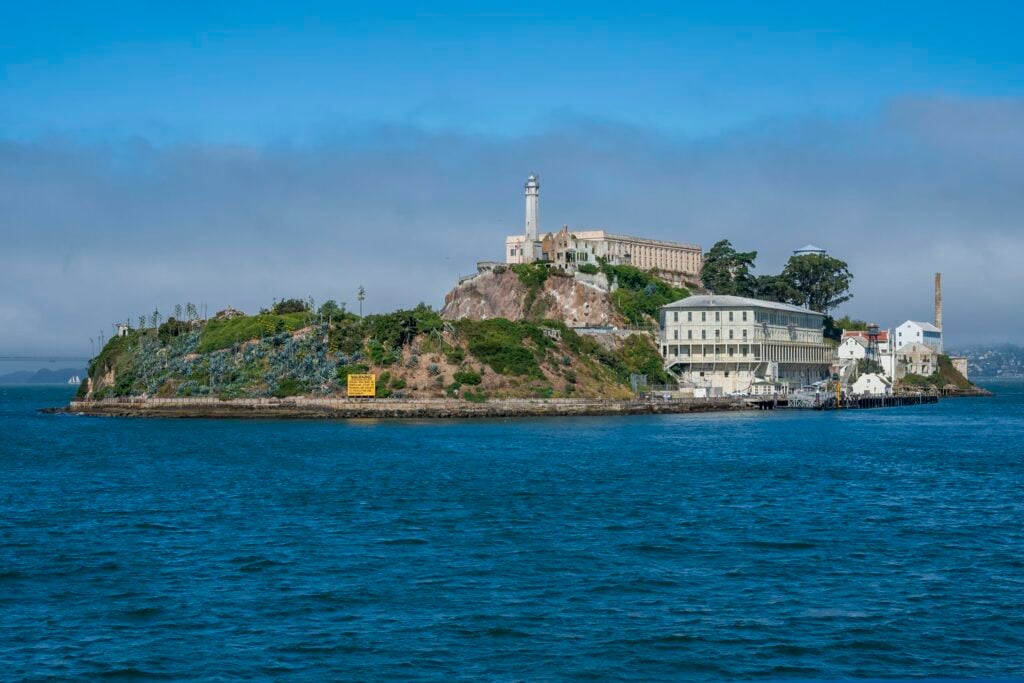
History Repeats Itself on Alcatraz 25 Years Later
The Rock had softened since Cole and Roe disappeared into the fog, but the air of mystery surrounding Alcatraz was now part of popular culture. The rule of silence had been lifted and now the prisoners could mentally escape a few hours each night with radio programs piped in via headsets. There were two channel options. The programs varied from music, sports, radio theatre and talk shows. Prisoners could rest on their cot, eyes closed and get a taste of life in the free world. Since the escape of Cole and Roe, there had been eleven other break attempts with the last occurring in June of 1962. Frank Lee Morris along with brothers John and Clarence Anglin had disappeared into the darkness of night and were never seen again. They created a master plot, using dummy heads as decoys and tunneling through the ventilation grill in their cells, made it to the roof and shoreline. They then paddled off in a homemade raft and other flotation devices never to be seen again. For prison officials, it was a familiar quandary. Convicts had debated the fates of Cole and Roe for a quarter century and now Morris and the Anglin brothers dominated much of the chatter of both the cons and officers. Alcatraz had lost its edge and the debates of whether they survived or perished were fierce.
As prison officials were once again working to strengthen security measures on Alcatraz to avoid other break outs, another group of convicts assigned to the kitchen detail had also been plotting their own break and some evidence would even suggest that their plot had been discussed with key players in the June ’62 escape, which had already been in motion.
John Paul Scott [1403-AZ] arrived on Alcatraz in April of 1959, following a brazen escape attempt from the federal penitentiary in Atlanta. Scott, along with legendary fugitive James “Whitey’ Bulger, Charlie Catalano, Stephen Kritsky and Louis Arquilla (all would earn a residence on Alcatraz) built a make shift ladder out of pipes and attempted to escape onto the roof of the prison hospital. The ladder collapsed and the convicts found themselves stranded on the roof, with no safe option to escape.
Scott was born and raised in Kentucky and was a military veteran who had served in the Air Force. After completing a four-year commitment and re-enlisting, it was discovered he had a criminal past. The Air Force provided him with an honorable discharge for his years of service. He adjusted well in the military but had challenges blending into free society. Scott would turn to a life of crime as a bank robber and found his way back in the care of the government but this time on the wrong side.
Scott and Parker Make Their Escape from Alcatraz in December 1962
Scott, along with Darl Dee Parker [1413-AZ], a 31-year-old serving a 50-year sentence for armed bank robbery, were both assigned to the culinary detail. They were working in the kitchen with common access into the basement area (now a modern retail store on Alcatraz) and over what was believed to have taken place over the course of several months, likely involving other accomplices, sawed through the bar frame using abrasives and other items. An official report read: “We are not quite sure of all instruments used to sever these bars, however, we are rather positive that a spatula, with serrated edges; a grease scraper, used by fry-cooks in scraping down grills, that had serrated edges; string, which had been impregnated with floor wax and scouring powder were at least three items that were used to sever these bars. One set of these bars, incidentally, is commonly referred to as “tool-proof-steel.”
The brilliance of the escape came in the flotation devices they created. Using surgical gloves secreted from the prison hospital, they were sewn inside cutoff shirtsleeves and used as water wings, similar to those used by pilots. James “Whitey” Bulger later claimed it was Scott’s survival training in the Air Force that gave him the idea of crafting water wings. They were made to keep pilots that had ditched their aircraft afloat, even if they were unconscious or exhausted, and this gave him the idea to replicate their design. Fellow convict Robert Schibline, 1355-AZ, had also recommended the same device types to Frank Morris, but he had apparently decided against it.
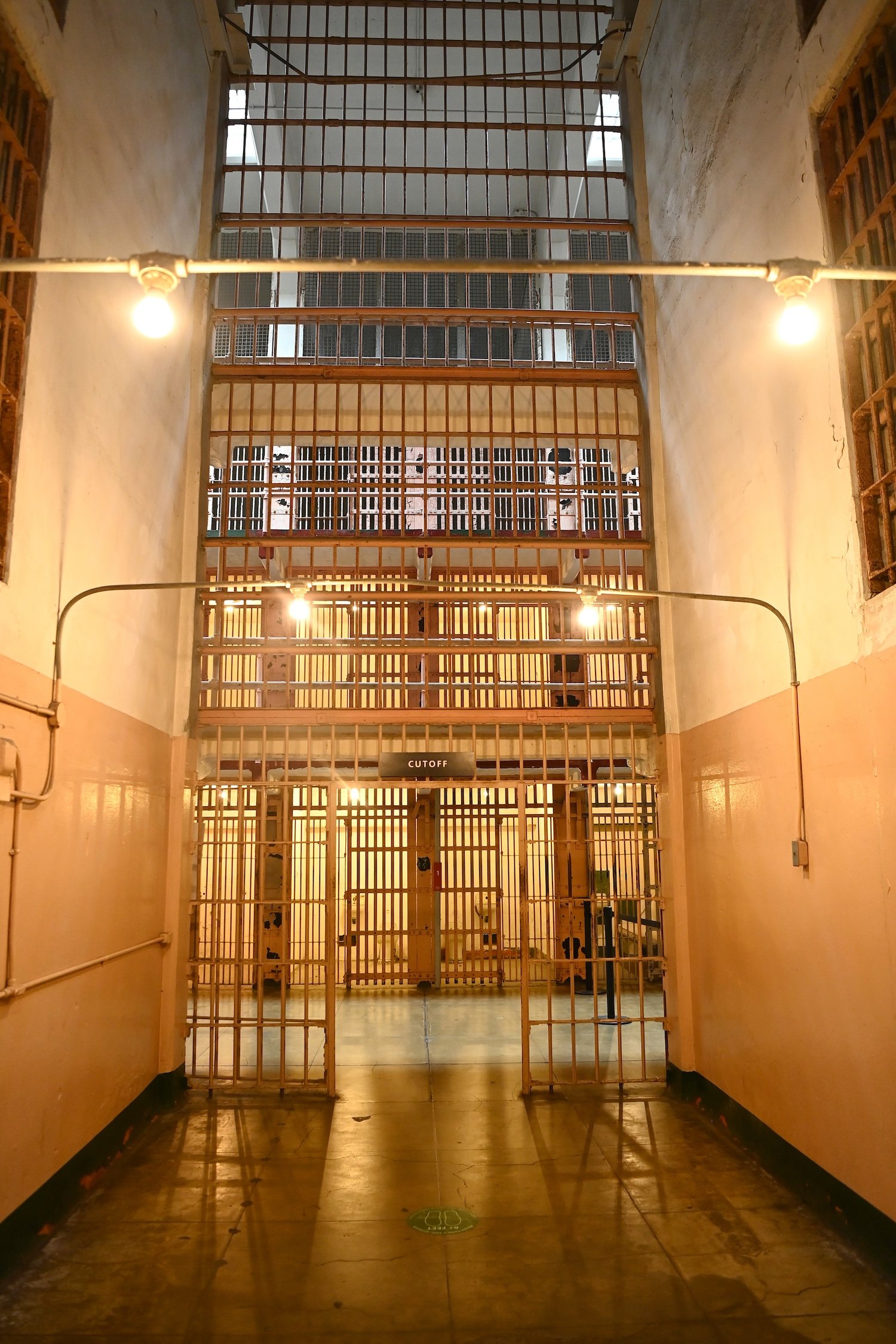
Scott and Parker were able to exit the basement area then scale onto the roof of the prison climbing the exact set of bars that ironically was featured in the film Escape from Alcatraz with Clint Eastwood. While Clint Eastwood climbed down these pipes in a Hollywood depiction of the June ’62 escape, Scott and Parker climbed up, walked across the rooftop of the prison to the other side, and then using an industrial extension cord, scaled down the building and then entered the water by the officer’s apartments.
The sun had set and it was raining and cold. There was rolling fog and visibility was poor. As Parker slid down the steep slope behind the apartment building, he twisted and seriously injury his foot. He entered the water and fighting the currents, only made it as far as the little rock known as Little Alcatraz and held there until he was rescued a little after 6:00 PM. Scott seemed to make better headway and floated towards the Golden Gate Bridge. The Coast Guard and the Alcatraz launch searched the fog laden waters with no luck locating Scott. In the freezing waters, he battled hypothermia and became completely disoriented. His interview with the FBI, later recorded on a small reel to reel tape machine, carried the statement that while in the water he lost his bearing. The fog was thick enough where he couldn’t see land. He could hear sounds from the mainland but with his head close to the water surface and the sounds seeming to echo from various points, he started to panic not knowing what to direction to swim. He stated his hands and legs felt so numb, he thought he was going to die. He could hear boats but couldn’t tell where or how far they were away.
At a little after 7:20 PM, more than an hour of being exposed to the freezing cold water, Scott was discovered clinging to a large rock at Fort Point, located at the base of the Golden Gate Bridge. A rescue team was dispatched and he later claimed to the FBI that he had no memory of being pulled from the rocks. His core body temperature had dropped to dangerous levels and was stabilized at Letterman Army Hospital, located on the Presidio of San Francisco. He was returned to Alcatraz the same evening and it forever shattered the escape proof reputation of Alcatraz.
John Paul Scott had proved that it was possible to escape using crudely fashioned flotation devices and most notably break past the tool proof steel bars. James Bennett, the Director of the Bureau of Prisons, came to San Francisco and held a press conference. He showed photographs of the escape and sawed bars of the windows attempting to explain how their work went unnoticed. Reporters asked tough questions, wanting to understand how less than six months earlier there was another escape that breached security. The administration had already been working towards closing the prison but for the Bureau of Prisons, Scott’s escape remained an embarrassment.
Three months later, on March 20, 1963, after 29-years as America’s most notorious prison, Alcatraz closed its gates. The bars are now rusted but the mystique of the prison still remains. You can stand at the very window where Scott and Parker made their historic escape in 1962. The window is easily visible and is located inside the main bookstore on Alcatraz. The repaired bars are easy to spot and you can get a sense of the challenges the men faced as they squeezed through then scaled the pipes onto the roof… It must have been an amazing view from the roof of the Cellhouse. It’s one of the great layers of history that makes Alcatraz so rich and interesting.
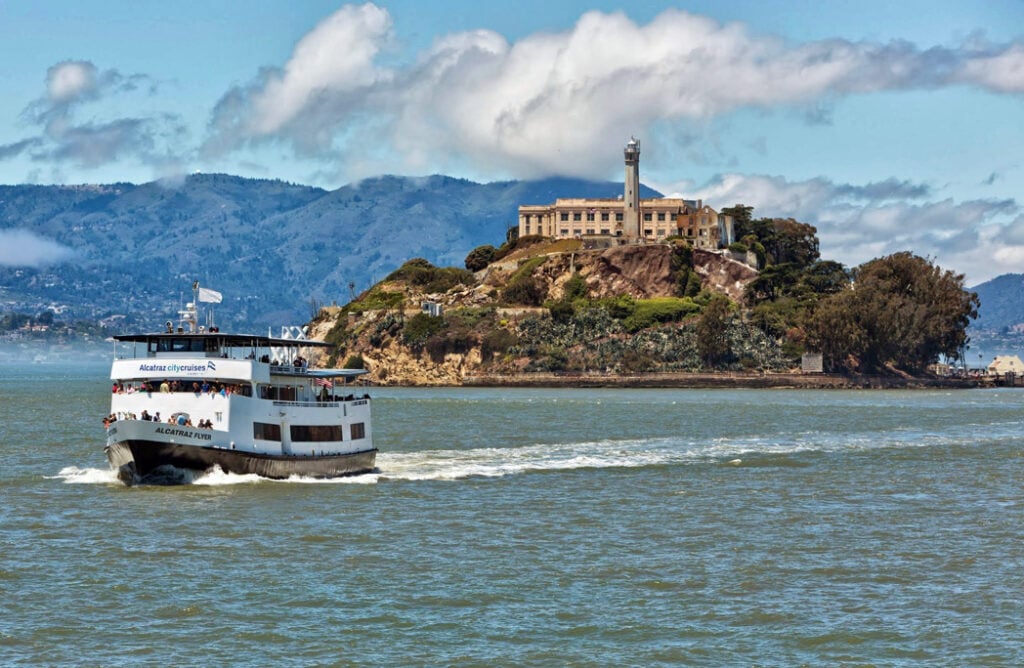
Depart to Alcatraz Island with Alcatraz City Cruises
Alcatraz has housed some of the most infamous criminals in history. Notorious gangsters like James “Whitey” Bulger, Al “Scarface” Capone, and George “Machine Gun” Kelly have spent a sentence or two at the Alcatraz Cellhouse. And now is your chance to explore this piece of history with Alcatraz City Cruises. There are multiple tour options to select from, which means there is something for everyone! Favorites include the Alcatraz Behind the Scenes Tour, where visitors will be able to discover areas that are otherwise not available to the public. This 4-5-hour tour will take you all around the off-limit areas, before joining up with the Alcatraz Night Tour. On the night tour, visitors will get the chance to enjoy a sunset from the island, while experiencing the many moods and exclusive tours and activities of Alcatraz after dark.
Original Post Date: December 4, 2018
Featured in this post
Keep Exploring
San Francisco, California
Alcatraz City Cruises
Explore More

 Discover Experiences Near Me
Discover Experiences Near Me
